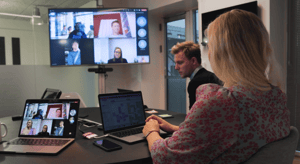In this era of hybrid work, virtual meetings have become essential. However, meetings are productive and valuable only if everyone attending follows appropriate meeting behavior. Virtual meeting etiquette are a vital part of standard workplace behavior, so it is worth taking the time to ensure everyone is on the same page. If you have bad habits in your meeting culture, it can create a snowball-effect of bad habits which, when added together, result in an entirely toxic meeting culture. So, here we have collected the most essential meeting behaviors that can help you have a successful virtual or hybrid meeting.

9 virtual meeting behaviors to improve meeting experience
1. Get off to a good start
When starting a virtual meeting, it is important that all participants follow the same basic meeting etiquette. Poorly managed meetings damage employee morale, so it is important to get things right from the start. It is often helpful to spend a few minutes with participants introducing themselves, depending on the size of the group. You can save time, however, if the team leader or meeting chair introduces them instead. Finally, depending on the degree of formality or whether participants know one another, a friendly group hello may be all that is needed.
If you decide to use icebreakers to ease into the meeting, try to keep them short to avoid eating into the meeting time. The best plan is to create a schedule for the meeting and make sticking to it a high priority. Inefficient and unnecessary meetings cost US businesses approximately $37 billion a year, so make sure you stick to your virtual meeting etiquette.
2. Become friends with the camera
Cameras are a crucial element in virtual meetings as they allow participants to see each other and facilitate face-to-face interactions, just like in in-person meetings. However, it is quite common for people to either turn off their cameras or use them in a way that hinders visibility.
To ensure a successful virtual meeting, it is imperative for all participants to establish a friendly relationship with the camera, even if they only appear on camera while speaking. This involves taking certain measures to optimize camera usage:
Firstly, it is important to be in an environment with adequate lighting that allows the camera to clearly capture your facial expressions. This ensures that others can see your reactions and engage with you effectively.
Additionally, it is crucial to position the camera at the correct level, ensuring that your face appears centered and is not viewed from an awkward angle. This helps create a more natural and engaging visual experience for all meeting participants, by avoiding unnecessary distractions from camera movements and positions.
3. Know where to look and whom to address
The camera should be positioned so you can look into it while speaking. It is the equivalent of eye-to-eye contact, whether you are seated at a desk in your home office or standing in front of a whiteboard. If your arrangement does not allow you to look straight into the eye of the camera, you might look like you are staring into space or focused on something other than people at the meeting.
In a hybrid meeting, some people may attend in person, in an office, or meeting room. If that is you, it may take a bit of trial and error to find a camera position that allows you to address both in-person and virtual participants. Therefore, an essential virtual meeting etiquette is to try and divide your attention equally by addressing and speaking both to the camera and to the people in the room, so you help them all feel part of the same meeting.
4. Decide whether cameras should be on or off
In virtual meetings, it is usually beneficial for all participants to turn on their cameras. Seeing your colleagues' faces allows speakers to gauge their reactions to what they are saying. However, there are situations where it might be more appropriate to turn off cameras.
People with slow connections might find their audio performance improves if they turn off their video stream. In addition, if team members listen to a speech or watch a presentation, without the expectation to participate, it may not be vital for them to have their cameras on. If someone cannot have their camera on, they should address it to the others up front.
The main benefit of requiring cameras on is that it reduces the temptation for meeting participants to multitask. You must judge each situation to decide whether some people have a justifiable reason to disable their cameras during a virtual meeting.
5. Do NOT multitask
One of the biggest pitfalls of virtual meetings is that they provide opportunities for people to multitask, instead of giving their full attention to the speaker. In a recent survey, an incredible 99% of people admitted to multitasking in digital meetings. Make it clear to all meeting participants that multitasking during meetings is unacceptable workplace behavior.
People can see when someone is doing something else instead of concentrating on the meeting, which can be both offensive and distracting. Be careful with your and everyone else's time and only attend meetings where your presence is necessary, then it becomes much easier to make sure to give those your full attention.
6. Consider your background
All businesses should set ground rules about backgrounds during virtual meetings. Both the one you have physically behind you, but also the desktop background is important to consider as you often share your screen at a virtual meeting.
One solution is for everyone to use a standard background supplied by the company. The advantage of using a corporate background is brand awareness. When everyone uses a corporate background, it can help create a professional environment and remind people of the company's logo, values, or slogan.
If you want people to have the opportunity to be more personal with their backgrounds, it is a good idea to consider guidelines, such as "no laundry showing in the background" to avoid embarrassment, distraction, or conflict. When working from a cafe or from home with busy backgrounds or other sorts of distractions it is important to consider whether that is appropriate for your meeting seeing how those distractions can kill focus for those watching.
7. Set a dresscode
Wearing appropriate attire is an important part of workplace behavior, which does not change during virtual meetings. Working from home often means that people tend to forget these things. Therefore, it is important to consider making it a virtual meeting etiquette, so everyone show up to a virtual meeting wearing clothing appropriate for their work environment.
Depending on the organization, the dresscode could consist of wearing formal attire like dresses and shirts, or always wearing clothing with company branding that clearly displays the employee's affiliation with the company. It could also simply require participants to dress as they would in the office, or at least wear clothing that provides full coverage. Having the same dresscode for at-home and in-office participants is a great way to keep things simple and consistent.
8. Handle meeting-breaks appropriately
Handling breaks during a virtual meeting can be tricky, so it is a good idea to have a virtual meeting etiquette addressing this. How can you ensure everyone is ready to resume the meeting on time when they are not physically in the same location?
Setting a firm time for restarting the meeting is the first step. Next, remind participants to turn off their mics and cameras during the break to maintain a professional atmosphere in the virtual meeting room. Let participants know that if they forget, they will be muted, their video will be disabled, or they will be removed from the meeting.
9. Handle questions like a pro
In addition to the various features offered by virtual meeting platforms like Microsoft Teams, there are also tools available that make it easy for participants to ask questions during a meeting. One such tool is the virtual hand-raising feature, which allows individuals to virtually indicate their desire to ask a question. This feature not only streamlines the process of asking questions but also helps to maintain the smooth flow of the meeting.
When using the virtual hand-raising feature, participants can simply click a button or use a designated keyboard shortcut to raise their hand. This action notifies the speaker or the meeting chair that someone has a question or comment to make. The speaker or chairperson can then decide when to address the raised hand, ensuring that it aligns with the agenda and does not disrupt the flow of the meeting.
Conclusion - match etiquette to your workplace behavior
Do you have more virtual meeting behaviors to add to the list? You should find the virtual meeting etiquette matching your company and fitting your workplace behavior, and make them your own. But consider making some standard guidelines, also to help make sure your employees are feeling comfortable in virtual meetings.
If everyone is on the same page and issues are being addressed you can create a transparent and trusting environment for your employees where they are not in doubt about what is being expected of them in the virtual meeting setup.




